Spiritual Examination: How Deep Is Your Focus?
Written by Johnathan Armstrong
 When we examine ourselves spiritually, do we just look at the surface—or do we employ a high-powered spiritual transmission electron microscope?
When we examine ourselves spiritually, do we just look at the surface—or do we employ a high-powered spiritual transmission electron microscope?
As Passover quickly approaches, we are to be taking the time to examine ourselves. “But let a man examine himself, and so let him eat of the bread and drink of the cup. For he who eats and drinks in an unworthy manner eats and drinks judgment to himself, not discerning the Lord’s body” (1 Corinthians 11:28-29).
The time leading up to the Passover is one of personal reflection. We are to be evaluating how we have done the last year and how our relationship with God is. Is it better? Is it worse? We are to be searching for the hidden “leaven”—sin.
How are we examining ourselves? How much effort are we putting in, and what level of magnification are we using to look?
An analogy from science
A powerful tool in the scientific community is the electron microscope.
Most of us are familiar with the standard optical microscope that uses light and various lenses to enable us to view tiny elements of life that we could not see with the naked eye. With an optical microscope we can see something the size of a human cell. That is pretty small!
But an electron microscope is used for examining the even tinier building blocks of life. This type of microscope measures things on the nanometer scale. For those unfamiliar with this term, a nanometer is one-billionth of a meter.
When you start looking at things on the order of nanometers, you are looking on the atomic scale. We are talking about breaking things down into their most basic components. For example, a single water molecule, two parts hydrogen and one part oxygen, is smaller than one nanometer.
The way an electron microscope works is by accelerating a collimated beam of electrons using high voltages and focusing them through a series of electrostatic lenses onto the sample of study. There are two basic types of electron microscopes: scanning (SEM) and transmission (TEM).
Scanning electron microscopes use the beam of electrons to hit the sample, and the electrons that are reflected off the sample are collected and used to image the sample. Scanning electron microscopes are good for imaging things that are 50 nanometers or larger.
Transmission electron microscopes, on the other hand, provide high-quality and high-resolution information by allowing the electrons to pass through the sample. The information from electrons collected on the other side, while more difficult to understand at first due to diffraction patterns and such, is much more useful. TEM truly allows imaging below one nanometer. TEM gives scientists the ability to see things down to specific atoms. It truly is incredible.
Our spiritual microscope
How deep does our spiritual examination go? Are we just focusing on the surface? Or are we really getting to the core of the issues we face?
Are we searching ourselves diligently enough (2 Corinthians 7:10-11; Mark 7:15, 20-23; Psalm 51:6, 10)? It takes more energy for those microscopes to reach those very tiny imaging capabilities. How much energy are we putting forth? What kind of effort do we expend on looking at ourselves?
We cannot just focus on our outward actions. We have to go deeper than that. Our actions come from our thoughts and our thoughts from our motives and our motives from our core, our nature, our heart.
When we are baptized, we make a commitment to change who we are. We start by changing what we do. We progress to changing the way we think. That proceeds inward to our desires. When we change our desires, we go deeper and change our very nature.
We have to take our self-examination seriously. We are warned of the judgment that is before us if we do not come to the Passover ready, with the right mind-set and attitude toward what we are doing there. Let us look at the innermost part of our being! “Let us search out and examine our ways, and turn back to the LORD” (Lamentations 3:40).
For more information that can help in our spiritual self-examination, see the sections on the 10 Commandments, sin, repentance and conversion.
Johnathan Armstrong attends the Little Rock, Arkansas, congregation of the Church of God, a Worldwide Association, and is a graduate student working on his doctorate in physics.










